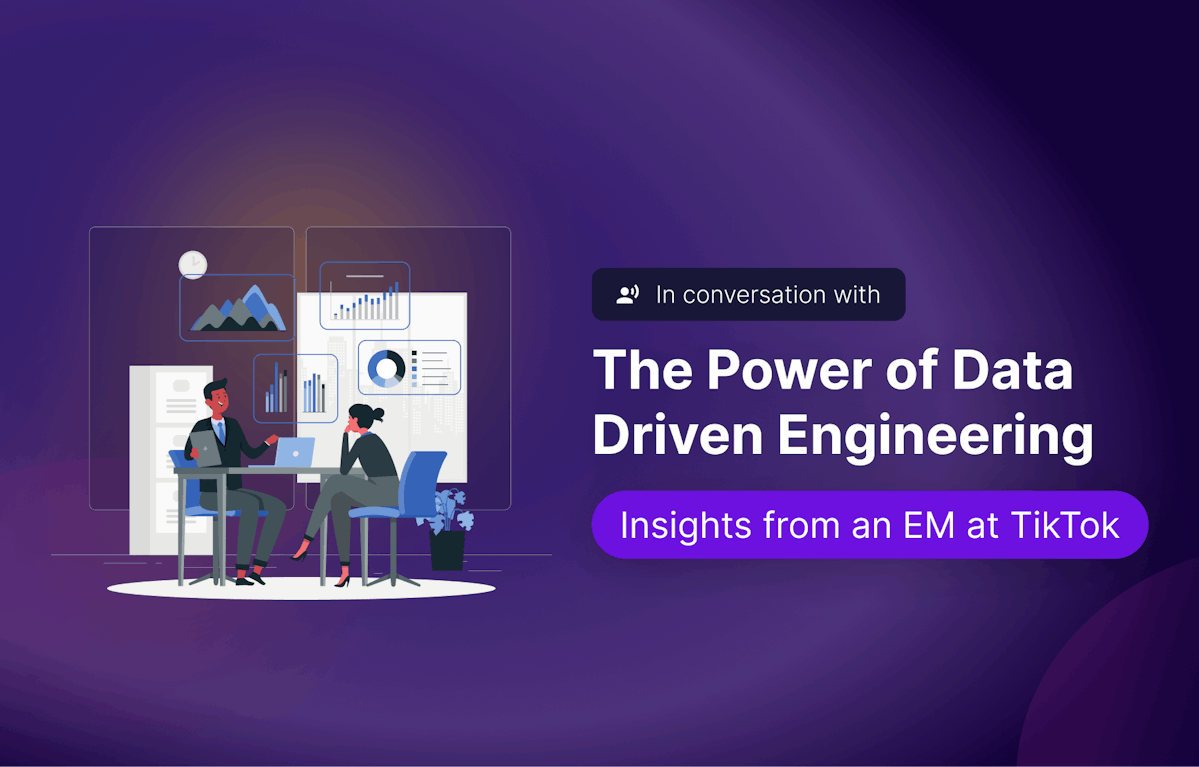Gone are the days of relying solely on gut feelings or stories from the past. Data has become the key to confidently guiding your team towards success. Whether it's improving processes, predicting trends, or understanding user behavior, data-driven strategies are essential for a modern business.
While meticulous detail is often applied to charting the course for success in project planning and execution, true success extends beyond simply pushing projects forward. It's about understanding the impact and return on investment (ROI) these endeavors bring—a critical aspect often overlooked in traditional approaches.
Today, we find engineering leaders and their respective teams under a microscope for effectiveness, delivery speed, and innovation.
In this journey towards achieving data-driven excellence, engineering leaders play a pivotal role. They possess the unique ability to transform raw data into actionable plans, empowering their teams to thrive in an environment where evidence-based decision-making is paramount.
We are extremely excited to share with you some leadership insights from one of these visionary leaders—Akshat Malu, Engineering Manager at TikTok in this blog here today. So stick around as we explore how data has shaped his leadership style and propelled his team towards success.
Meet Akshat, Engineering Manager @Tiktok
Data-driven leadership is an art perfected by those who see beyond the numbers, and understand the stories they tell. Akshat Malu, with his vast experience spanning from Microsoft to TikTok, is a paragon of such leadership.
Akshat ventured into Microsoft, where he explored a multitude of roles over a span of 12 years. Today, he holds the position of an Engineering Manager at TikTok, with formidable expertise in the field of machine learning and Natural Language Processing (NLP).
At the core of Akshat’s approach is a profound belief in the power of data to not only drive user engagement but also to illuminate the path for his engineering team.
We expand more on this below.
Building a Data-Centric Team Culture
The potential of vast data resources to drive innovation in engineering teams is immense, supporting new ideas with solid evidence. However, even the largest tech companies struggle to establish a robust, data-driven culture where decisions are universally based on data.
Why is this?
It may sound like a cliché, but business leaders must lead by example to cultivate a future-proof, data-driven culture. In such a state, leaders like Akshat have a different approach.
They go beyond simply making data-driven decisions; they foster an environment where data is more than a resource—it's a mindset. By encouraging his team to engage with data, share insights, and foster data-driven discussions, Akshat ensures that the value of data is ingrained in the team’s approach.
Akshat believes in giving the power of autonomy to his team members in managing their tasks.
"I've learned the importance of being flexible with timelines. Micromanaging doesn't lead to success. Giving people the freedom to work on their projects and learn from their mistakes is essential for their growth. It's about nurturing a culture where individuals can thrive and make their own decisions, rather than dictating every detail to them."
On keeping a track of his team’s deliverables, Akshat adopts a hands-on approach:
“TikTok specifically is very heavily driven by impact. We strive for deliverables from the team almost every quarter, which serves as our primary tracking mechanism. In addition to metrics and impact, I personally monitor areas of improvement and each person's strengths. This insight guides my conversations and helps me coach team members effectively to foster their growth."
This approach has enabled him to effectively manage teams across different time zones in the US while keeping track of their progress. Additionally, it allows him to understand his team members' expectations, manage their professional growth, and ensure their tasks align with their career aspirations.
Why Choose to Lead with A Data-Driven Approach?
The push to incorporate data and analytics into business is widespread, and the numbers to support this claim speak for themselves.
Companies that embrace data-driven strategies are significantly more successful compared to their competitors:
- They are 23 times more likely to excel in customer acquisition.
- They are about 19 times more likely to maintain profitability.
- They are nearly 7 times more likely to retain customers.
But Akshat has a unique perspective on using data to enhance his machine-learning techniques. He says, “We want to improve everything, but trying to do it all at once isn't practical. Prioritizing is crucial. In the past, choices were often made based on gut feelings or what seemed beneficial. However, using data means going back to our plans, analyzing them thoroughly, and checking how well they're working. Understanding how users behave and their different experiences helps us decide what to focus on first. This approach has helped us see direct and accelerated results."
Today, the digital landscape is a testament to the exponential rate of change. For engineering leaders like Akshat, staying ahead means leveraging data to navigate through the complexities of user engagement and team dynamics.
The need for a data-driven approach stems from several fronts:
- Complexity and Scale: Managing recommendation algorithms for a platform like TikTok involves intricate data analysis to understand system performance across various user segments and generating insights on how to improve it.
- Rapid Innovation: In the tech industry, where yesterday's innovation is today's norm, data helps in identifying trends, predicting user behaviour, and driving product evolution.
- Team Dynamics and Scalability: As teams grow, the challenges evolve. Data aids in understanding team performance, project progress, and areas requiring intervention.
"A data-driven approach is crucial in navigating the complexities of user engagement and team dynamics. It involves intricate data analysis to understand user preferences and deliver personalized content to our users effectively," says Akshat.
For leaders like Akshat, each piece of data from user interactions is valuable. By studying how users engage, his team can improve TikTok's recommendation algorithm, making sure the content connects with the audience.
This meticulous approach to data analysis forms the bedrock of strategic planning, from algorithm improvements to feature rollouts.
How to Balance Data with Intuition?
Balancing intuition with data presents a unique challenge for leaders.
Leaders often grapple with the age-old question: should decisions rely more on intuition or rigorous data analysis? Intuition provides quick insights based on experience, while data-driven decisions depend on empirical evidence and analysis.
So, what's the best approach?
Akshat's strategy involves using data to guide decision-making while also considering intuition. This balanced approach ensures that leadership decisions are informed by data while remaining sensitive to human factors.
"I believe in letting data guide our decision-making process while also acknowledging the importance of intuition, especially in scenarios where data is inconclusive. It's about finding that balance between being data-informed and human-centric in our leadership decisions."
Ensuring data quality and relevance is crucial in a world flooded with information. Akshat emphasizes the need for robust data governance policies to uphold data integrity, ensuring that decisions are based on accurate and meaningful insights.
Five Tips for New Engineering Managers Leading a Team
We asked Akshat for five tips he’d give to new engineering managers, and here's what he shared:
- Avoid Micromanaging: Akshat emphasizes the importance of giving team members space to make decisions and learn from experiences. Micromanaging can stifle growth and autonomy.
- Manage Time Expectations: Be realistic about timeframes, especially when working with junior team members. Setting reasonable expectations and allowing for uncertainties can lead to more achievable goals and reduce stress.
- Communicate Realistic Timelines: Involve team members in setting timelines. Ask for their input on achievable deadlines to avoid overcommitting and ensure better project planning.
- Underpromise and Overdeliver: Set modest goals and timelines initially. It's better to exceed expectations than to fall short. This approach helps boost team morale and ensures more realistic project outcomes.
- Set Realistic Goals and Deadlines: Consider team capacity and potential challenges when setting goals. Avoid imposing hard cutoffs that may become unattainable over time.
These tips reflect Akshat's insights into effective leadership and project management, focusing on fostering independence, managing expectations, and achieving successful outcomes through realistic planning and communication.
What Does This Mean for Data-Driven Leadership in 2024?
This conversation with Akshat, EM at TikTok, highlights a significant shift in engineering leadership within top organizations, as more and more leaders are adopting a data-driven approach and more importantly a data-driven culture within their engineering teams.
The key idea here is that addressing challenges effectively requires looking inward and taking action based on insights from data. This trend is supported by reports showing that data-driven organizations experience over 30% more annual growth.
Key Takeaways:
- Engineering teams need to adopt a data-driven culture to thrive in today's competitive world.
- Data helps understand user behaviour, predict trends, and drive innovation in fast-changing tech industries.
- Making decisions based on data analysis helps teams achieve faster and more impactful results by focusing on high-value areas.
- Leaders should lead by example to promote a data-driven culture within their teams.
- Good leadership means using both data and intuition to make decisions, especially when data is unclear.
Not adopting this approach in such a fast-paced environment means missing out on a critical step: a forward-thinking approach. To easily adapt this forward-thinking approach, talk to our productivity experts today and they'd be happy to help you!



